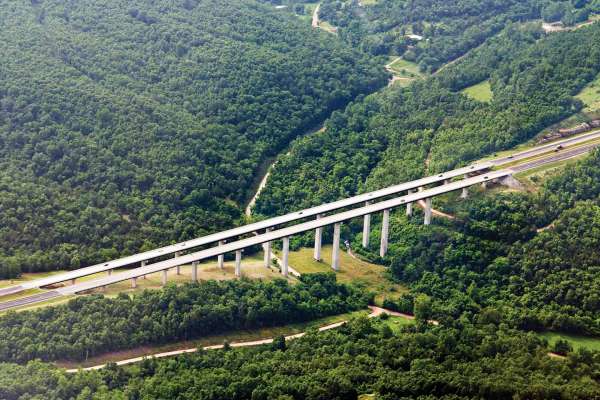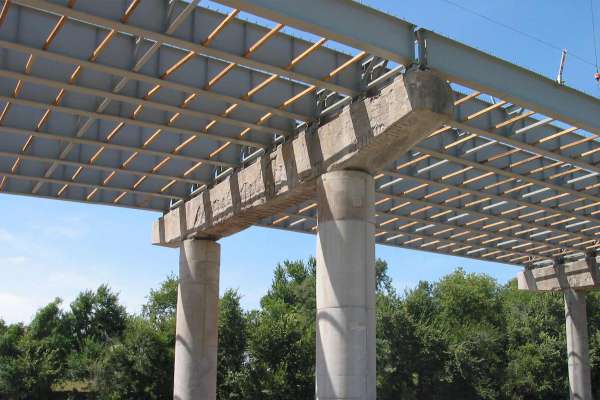Garver is meeting the growing demand for bridge rehabilitation services
A generation of bridges across this nation were constructed in the 1950s and 1960s, and many of these Baby Boomer structures now require reconstruction and rehabilitation.
According to the American Association of State Highway and Transportation Officials (AASHTO), nearly 40 percent of all bridges across the country are 40 years or older. In fact, while most bridges are built to last 50 years, the average bridge is now 43 years old.
Due to this aging process, AASHTO reports that one in four rural bridges is structurally deficient or functionally obsolete. And in our towns and cities, the numbers are more ominous—one in three urban bridges requires posted limits or cannot adequately accommodate current traffic volumes.
Now more than ever, experienced bridge inspectors and structural engineers are needed to evaluate and rehabilitate our aging bridges.
Garver, LLC has provided bridge inspection and design services throughout much of our 90-year history.
"We take pride in our work," said Garver Structural Engineer Jason Langhammer, PE. "We evaluate bridges for structural or functional problems and work to correct them with quality design plans."
As experienced professionals, Garver is providing bridge inspection services throughout the South and portions of the Midwest. In Oklahoma, we've serviced 30 bridges in the past three years. In Arkansas, we've tackled historic bridge repairs. In Tennessee, we're completing our 19th consecutive year of bridge "on-call" services for the Tennessee Department of Transportation.
Many of Garver's inspections coincide with our bridge repair projects throughout the region. Garver has a wide range of bridge repair experience in both scope and geography, and our engineers have managed and designed repair projects ranging from $100,000 to $30 million.
"We have the experience, the education, the training, the know-how," said Garver Structural Engineer AJ Khairi, PE. "Garver provides bridge repair plans for a variety of structures—steel, cast-in-place, pre-stressed concrete, truss. We don't just specialize in one area. We've seen them all. Our strengths in bridge repair stem from our full understanding of a client's needs regarding budget, structural capacity, environmental constraints and time restraints. We provide suitable and workable solutions that resolve existing bridge structure deficiencies."
When working on a bridge project, Langhammer stressed the importance of moving beyond a scientific approach to investigate its physical footprint and functionality as a whole.
"We consider approach roadways, the features running below the bridge and how the entire system works together as part of the bridge improvement project—things that numbers alone can't tell you. Often, we're not only going in and upgrading or repairing the bridge, we're fixing problems related to drainage or safety issues like substandard guardrails and bridge widths."
During the initial phase of a project, Garver prepares a formal engineering report based on inspection findings, surveys and geotechnical investigations. This report includes details and photographs of all site conditions—the bridge deck and wearing surface, the superstructure and all primary load-carrying members and connections, and the substructure, including the abutments and piers. Additionally, the substructures are checked for structural adequacy against current design loadings. The bridge's components are identified for deterioration, and repair recommendations are summarized by supportive text and graphics.
Garver's engineers then prepare rehabilitation design plans. These documents outline methods and extents of repair in coordination with the client's construction specification system. The design also details the entire site for associated approach roadways, safety equipment, grading, drainage and maintenance of traffic.
As a comprehensive services firm, Garver also provides underwater inspection and evaluation, scour analysis and studies, seismic retrofit, bridge jacking and maintenance of traffic* as part of its wide range of work.
Garver's bridge inspectors have passed the National Highway Institute Safety Inspection of In-Service Bridges course. Among other skills, the course trains engineers to evaluate a variety of bridges and determine the critical areas for inspection, including fatigue-prone details and common points of deterioration and distress.
Our bridge inspectors and designers also stay up to date with the newest construction methods like fiber reinforced epoxy composite materials to repair concrete members and polymer-modified or latex-modified concrete to enhance concrete durability and bond strength.
"Bridges are the fundamental backbone of our transportation system," Langhammer said. "We work hard to do our job well—whether building rapport with our client, clearly detailing bridge deficiencies and solutions, or incorporating the latest technology."






Share this article